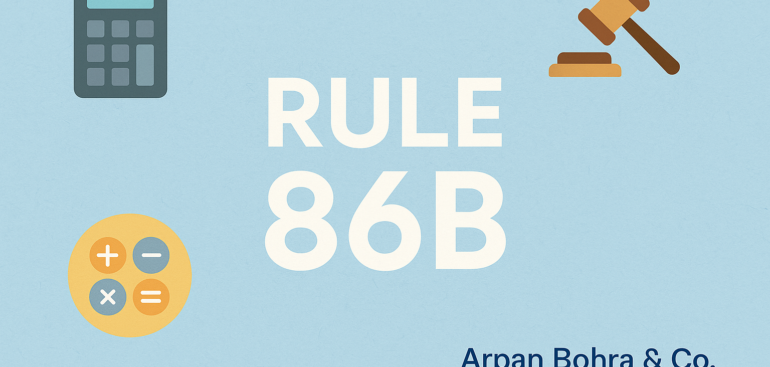Introduction
In the ever-evolving landscape of Goods and Services Tax (GST) compliance in India, Rule
86B of the Central Goods and Services Tax (CGST) Rules, 2017 has become a significant
provision that impacts the way businesses utilize their Input Tax Credit (ITC). Introduced
via Notification No. 94/2020 – Central Tax, dated 22nd December 2020, Rule 86B came into
effect from 1st January 2021.
What is Rule 86B?
Rule 86B places a restriction on the use of ITC available in the electronic credit ledger.
Specifically, it mandates that:
If the value of taxable supply (excluding exempt and zero-rated supply) in a month exceeds
₹50 lakhs, the taxpayer is required to pay at least 1% of the output tax liability in cash.
In simpler terms, even if a business has sufficient ITC, it cannot use it to discharge the entire
output tax liability if the value of taxable outward supplies (excluding exports and exempt
supplies) exceeds ₹50 lakhs in a month. At least 1% of the GST liability must be paid in cash
(i.e., using the electronic cash ledger).
Applicability Threshold
Applicable when taxable turnover in a month exceeds ₹50 lakhs, excluding:
- Exempt supplies
- Zero-rated supplies (such as exports or SEZ supplies)
Exemptions to Rule 86B - Rule 86B does not apply in the following cases:
If the registered person (proprietor, managing director, partner, etc.) has paid
income tax exceeding ₹1 lakh in each of the two preceding financial years.
– If the registered person has received a refund exceeding ₹1 lakh in the previous
financial year on account of: - Unutilized ITC due to zero-rated supplies without payment of tax
- Inverted duty structure
– If the registered person has paid more than 1% of total output tax liability in cash
cumulatively up to the month in the current financial year.
– Rule 86B does not apply to: - Government departments
- Public sector undertakings
- Local authorities
- Statutory bodies
- Illustrative Example
Suppose XYZ Pvt Ltd has taxable outward supplies of ₹75 lakhs in March 2025 and a total
GST liability of ₹13.5 lakhs. Even if XYZ has ITC of ₹20 lakhs in its electronic credit ledger, it
must pay at least ₹13,500 (1% of ₹13.5 lakhs) through the cash ledger, and the remaining
can be adjusted through ITC. - Conclusion
Rule 86B is a compliance measure designed to strengthen the GST system and ensure tax
discipline. While it does impose a cash liability on certain businesses, its impact can be
mitigated by maintaining proper records, timely income tax compliance, and refund history.
Understanding the scope and exceptions of Rule 86B is essential for businesses to avoid
surprises during GST return filing and departmental audits.

